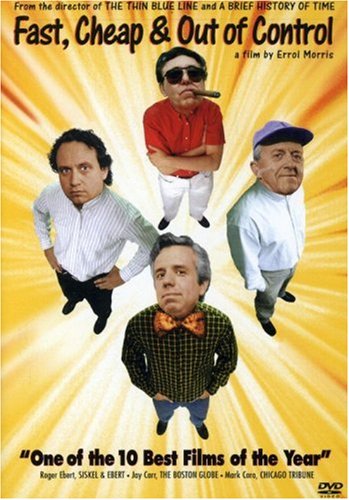
The title might throw a viewer off – ‘Out of Control’. A documentary about things being out of control sounds like a warning, or a plea for sanity. Early on when the subjects of the doc were talking, I was waiting for the filmmaker’s negative point of view to show itself, for the unspoken question of “what’s wrong with them?”
But it does not occur, because the goal in this film is not to hector, but to observe. Fast, Cheap & Out of Control profiles (without narration, just interviews and footage) four men in disparate, seemingly unrelated lines of work, and finds surprising thematic ways to connect them, and illustrate larger truths about the human condition.
The subjects are a lion tamer, a topiary curator, a wildlife photographer specializing in mole rats, and a robot designer.
The title comes from the last subject: Rodney Brooks of M.I.T. wrote a paper titled “Fast, Cheap, and Out of Control” proposing an idea of how to explore Mars robotically. Rather than send one heavy rover, he proposed sending a hundred small, cheap robots that would scatter around the planet, following simple instructions instead of direct control. If one was destroyed in its efforts, no big deal, there’s 99 more where that came from.
The robot’s movements would be behavior that emerged from simple rules. Emergent behavior is the unspoken theme of the movie – how from simple systems, complex behavior arises naturally.
The lion tamer, Dave Hoover, was inspired as a child by the adventure movies of wild animal trainer Clyde Beatty. Excerpts from one of Beatty’s ridiculous old serials are interspersed throughout Fast, Cheap & Out of Control, showing him traveling through Darkest Africa and facing death, again and again. Of course, the movie is an illusion of an uncontrolled world of danger for the character to face. For a lion tamer, it is the lack of danger that is the illusion. As Hoover describes it, the whole trick to his work is to maintain the illusion to the animals that he is stronger than they are, by closely observing the animal’s psychology. Even good-natured lions would take pieces off of him given the chance; he makes them believe they do not have that chance.
The remaining subjects are essentially environmental artists, one primarily, the other incidentally. George Mendonca created the topiaries in Green Animals Topiary Garden in Portsmouth, Rhode Island. Out of plants, he carves animals – maybe using a piece of metal here or there, but for the most part just knowing the plant, knowing how to cut, and having the will to spend years of growth and trimming perfecting a single sculpture.
Ray Mendez’s interest is the naked mole rat. He created an exhibit for the animals in a major zoo, and keeps an installation at his house, because he likes them. I use the word “interest,” rather than obsession, because none of the men interviewed displayed any manic, unhinged, or overwrought connection to their projects. Many descriptions and reviews of the film use the word “obsessed”, but obsession denotes a lack of perspective on the world, and from what I saw in the film, all of the participants had a sense of perspective. They just don’t let it get in the way of what they enjoy. Even Ray Mendez, who devotes some considerable amount of time and effort looking at ugly naked mole rats has a sense of humor about his project.
So if it’s not about obsession, isn’t haranguing us about human nature or exposing terrible truths, what is Fast, Cheap & Out of Control doing? I think the thesis of the film can be found in the repeated footage of the circus that the film routinely cuts too, even when the discussion has no direct reference to it. The circus is a mix of illusion of control and very finely practiced athleticism, a world of false danger mixed with real death-defying. The human cannonball is not propelled by gunpowder – the explosion is for show. But he does fly high in the air, and though he’s heading for a cushion, he’s still coming in fast, and has to land right. It’s a controlled event with the appearance of wildness… but that is nonetheless also dangerous.
Brooks’ robots (which resemble big insects) walk because of a series of systems that work together. They have not been given a specific “walk” program, but a number of sensor and feedback loops that create a barely controlled system that culminates in locomotion.
How exactly it works is not detailed in the film. None of these profiles are in depth, root to branch examinations of the subject. While we learn a few details about the mole rat (they use the last room in their tunnels for a bathroom, which everyone rolls around in to get the community scent, and they have some societal aspects that resemble insects more than mammals) but one does not come out of Fast, Cheap & Out of Control any kind of mole rat expert. Instead, you may come to have an understanding about why one would become a mole rat expert. Or a lion tamer. Or make topiaries.
The movie invites us to take a step back from our own perspective. Maybe, as Brooks speculates, consciousness is not some inherent property, but just an emergent effect from the various feedback systems that keep us walking up right, and out of lion’s jaws, and a lot of the control we think we have in all aspects of our lives is truly illusory.